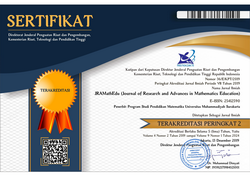Potential Effect of PISA Equivalent Questions Using the Context of Aceh Traditional Houses
Uliyatul Usnul(1*), Rahmah Johar(2), Hizir Sofyan(3)(1) Mathematics Education Department, Syiah Kuala University, INDONESIA
(2) Mathematics Education Department, Syiah Kuala University, INDONESIA
(3) Mathematics Department, Syiah Kuala University, INDONESIA
(*) Corresponding Author
Abstract
Keywords
Full Text:
PDFReferences
Aini, R.N. (2014). Analisis Pemahaman Siswa SMP dalam Menyelesaikan Masalah Aljabar pada PISA. Jurnal MATHEdunesa, 3(2), 158 – 164.
Apriyani, R., Somakim, S., & Darmawijoyo, D. (2017). Developing Teaching Material of Direct Proportion Based on Agricultural Context. Jurnal Kependidikan: Penelitian Inovasi Pembelajaran, 1(1), 38-49.
Buang, N.A. (2015). Komunikasi Budaya Melalui Pendidikan? Atau Pendidikan untuk Komunikasi Budaya?.Proceedings of ACER-N I Meeting and Seminar Fakultas Pascasarjana Universitas Pasundan, 1 – 4.
Boesen, J.L. (2010). The Relation Between Types of Assessment Task and The Mathematical Reasoning Students Use. Educational Studies in Mathematics, (75), 89 – 105.
Charmila,N., Zulkardi., &Darmawijoyo. (2016). Pengembangan Soal Matematika Model PISA Menggunakan Konteks Jambi. Jurnal Penelitian dan Evaluasi Pendidikan, 20(2), 198 - 207.
Gravemeijer, K., & Doorman, M. (1999). Context Problems in Realistic Mathematics Education: A Calculus Course as an Example. Educational Studies in Mathematics, 39, 111 – 129.
Johar, R. (2012). Domain Soal PISA untuk Literasi Matematika. Jurnal Peluang, 1(1), 30 – 41.
Kemdikbud.(2016). Peringkat dan Capaian PISA Indonesia Mengalami Peningkatan. https://www.kemdikbud.go.id/main/blog/2016/12/peringkat-dan-capaian-pisa-indonesia-mengalami-peningkatan. Diaksestanggal 09 Mei 2019.
Kurniasih, A. W. (2011). Identification Critical Thinking Stages of Students’Mathematics Education Study Program FMIPA UNNES for Solving Mathematics Problems. In the Fourth National Conference on Mathematics Education, P(63), 639 – 650.
Lithner.J. (2012). Mathematical Reasoning in Teacher’s Presentation. The Jurnal of Mathematical Behavior,JAI, 252 – 269.
Mansur, N. (2018). Melatih Literasi Matematika Siswa dengan Soal PISA. Prosiding Seminar Nasional Matematika I Universitas Negeri Semarang, 140 – 144.
Mardayanti, E., Zulkardi, Z., & Santoso, B. (2016). Pengembangan Soal Open-Ended Menggunakan Konteks Sumatera Selatan Materi Sistem Persamaan Linear Dua Variabel Kelas X SMA. Jurnal Pendidikan Matematika Sriwijaya, 10(1), 1-14.
Martani, B.T &Murtiyasa.(2016). Pengembangan Soal Model PISA Pada Konten Quantity Untuk Mengukur Kemampuan Penalaran Matematis Siswa. Prosiding Seminar Nasional Pendidikan Matematika Universitas Muhammadiyah Surakarta, 1 – 10.
Marwanda, T. (2017). Pengembangan Soal Setara PISA untuk Meningkatkan Kemampuan Komunikasidan Pemecahan Masalah Matematis Siswa. Tesis. Pascasarjana UniversitasSyiah Kuala. Tidak Diterbitkan.
Maqshum, A. (2017). Pengembangan Soal Kemampuan Problem Solving dan Komunikasi Matematis Setara PISA dengan Menggunakan Konteks Aceh. Tesis. Pascasarjana Universitas Syiah Kuala. Tidak Diterbitkan.
OECD. (2010). PISA 2009 Result: What Student Know and Can Do-Student Performance in Reading, Mathematics and Science. USA: OECD-PISA.
OECD. (2013). PISA 2012 Results: Ready to Learn Students’ enggagement and self-beliefs (Volume III).
OECD. (2016). PISA 2015 Result Excelence and Equity in Education (Volume I). Paris: OECD Publishing.
OECD. (2018). PISA 2018: Information About The PISA Study 2018. Le Gouvernement, Luxembourg.
Purnomo, S & Dafik. (2015). Analisis Respon Siswa Terhadap Soal PISA Konten Shape and Space dengan Rasch Model. Jurnal Seminar Nasional Matematika dan Pendidikan, PM(163), 1155 – 1160.
Putra, Y.Y., Zulkardi.,&Hartono,Y. (2016). Pengembangan Soal Matematika Model PISA Level 4, 5, 6 Menggunakan Konteks Lampung. Jurnal Kreano, 7(1), 10 – 16.
Ramdani, Y. (2012). Pengembangan Instrumen dan Bahan Ajar Untuk Meningkatkan Kemampuan Komunikasi, Penalaran, dan Koneksi Matematis dalam Konsep Integral. Jurnal Penelitian Pendidikan , 13(1), 44 – 52.
Simamora, R. E., & Saragih, S. (2018). Improving Students’ Mathematical Problem Solving Ability and Self-Efficacy through Guided Discovery Learning in Local Culture Context. International Electronic Journal of Mathematics Education, 14(1), 61-72.
Sroyer, A. (2013). Penalaran Kuantitatif (Quantitatif Reasoning) dalam Pemecahan Masalah Matematika. Prosiding Seminar Nasional Matematika dan Pendidikan Matematika Universitas Negeri Yogyakarta, P(6), 39 – 44.
Susanti, E. (2016). Pengembangan Soal Matematika Tipe TIMSS Menggunakan Konteks Rumah Adat Untuk Siswa Sekolah Menengah Pertama. Jurnal Pendidikan Matematika, 10(2), 1 – 21.
Tessmer, M. (1993).Planning and Conducting Formative Evaluation. London: Kogan Page.
Ulandari, L., Amry, Z., & Saragih, S. (2019). Development of Learning Materials Based on Realistic Mathematics Education Approach to Improve Students’ Mathematical Problem Solving Ability and Self-Efficacy. International Electronic Journal of Mathematics Education, 14(2), 375-383.
Wardhani, S &Rumiati. (2011). Instrumen Penilaian Hasil Belajar Matematika SMP: Belajar dari PISA dan TIMSS (Modul Matematika SMP Program Bermutu). Yogyakarta: PPPPTK Matematika.
Widada, W., Herawaty, D., & Lubis, A. N. M. T. (2018, September). Realistic mathematics learning based on the ethnomathematics in Bengkulu to improve students’ cognitive level. In Journal of Physics: Conference Series (Vol. 1088, No. 1, p. 012028). IOP Publishing.
Widjaja, W. (2013). The Used of Contextual Problem Support Mathematical Learning. Journal on Mathematics Eduacation, 4(2), 151 – 159.
Zulkardi. (2002). Developing a Learning Environment on Realistic Mathematics Education for Indonesian Student Teachers. Enschede: Print Partners Ipskamp.
Article Metrics
Abstract view(s): 857 time(s)PDF: 629 time(s)
Refbacks
- There are currently no refbacks.







